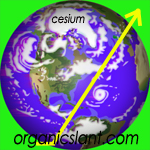 (Organic Slant) Radioactive cesium from the Fukushima plant was found at 10 points in the Pacific Ocean, including a location as far as 1300 miles from the plant, less than a year after Fukushima nuclear disaster began, scientists revealed.
(Organic Slant) Radioactive cesium from the Fukushima plant was found at 10 points in the Pacific Ocean, including a location as far as 1300 miles from the plant, less than a year after Fukushima nuclear disaster began, scientists revealed.
Researchers from the Japan Agency for Marine Earth Science and Technology were among the team members who released a report on the findings at a meeting of the Japan Geoscience Union at the Makuhari Messe international convention center in Chiba Prefecture.
The group collected zooplankton and surface seawater at 10 points between Hokkaido and Guam, 500 to 2,100 km from the crippled power plant, between Jan. 14 and Feb. 5, 2012.
Cesium 134, with a half-life of two years, and cesium 137, with a half-life of 30 years, were detected in plankton and seawater at all 10 locations, according to their report. Plankton with the highest concentrations of cesium 134, at 10.5 becquerels per kilogram, and cesium 137, at 14.9 becquerels, were found around 25 degrees north latitude and 150 degrees east longitude, the report said. The samples were taken from the surface to a depth of 200 meters.
“Plankton are thought to play a key role in the dispersion of the cesium because they are eaten by bigger fish. We want to study further what is influencing the accumulation of radioactive cesium,” said Minoru Kitamura, a marine ecologist and senior researcher at the Japan Agency for Marine Earth Science and Technology, who led the group.
The plankton could have been contaminated by eating even smaller plankton and through seawater, Kitamura said.
Meanwhile, the concentration of radioactive cesium in surface seawater was highest — at 41.5 becquerels per kilogram — from around latitude 36 to 39 degrees north, where the Oyashio Current meets the Kuroshio Current from the south, the report said.
Kitamura said they haven’t figured out why the concentrations of contamination differed in plankton and seawater.
“Our concern is the high level of (radioactive cesium found in plankton) taken from waters around latitude 25 degrees north, and we don’t know why the level got high around that area,” Kitamura said. “We need to study whether the concentration will decline, or stay the same.”
Impact on oceanic ecosystems
The study discussed the potential impact of the radiocesium contamination in zooplankton on oceanic ecosystems. Zooplankton communities contaminated with the Fukushima-derived radiocesium included many kinds of diel vertical migratory species. These migrants go and return between higher and lower radiocesium activity layers in a diel cycle.
Diel vertical migration, also known as diurnal vertical migration, is a pattern of movement used by some organisms living in the ocean and in lakes. The migration occurs when organisms move up to the epipelagic zone at night and return to the mesopelagic zone of the oceans or to the hypolimnion zone of lakes during the day. The word diel comes from the Latin dies day, and means a 24-hour period. It is referred to as the greatest migration in the world in terms of biomass.
In the subarctic/transition regions, accumulated radiocesium in the migrant’s bodies might be transported downward and uptake of radiocesium into the mesopelagic food web through biological activities was possible. Recently, Madigan et al. (2012) reported that Pacific bluefin tuna transported the Fukushima-derived radiocesium from around Japan to California waters. They discussed that sea turtles, salmons and migratory birds may also be transport vectors of the Fukushima-derived radionuclides.
The results suggest that marine animals may transport the radionuclides not only horizontally but also vertically. Although they studied the Fukushima-derived radiocesium contamination in zooplankton based on the materials collected from surface layers, the contamination in mesopelagic communities should be researched in the future.
Direct influence by high radiocesium activity in seawater correlated with the Mode Waters and vertical transportation of radiocesium though the active migration of zooplankton may be key processes of contaminations in subtropical and subarctical/transitional mesopelagic communities, respectively.
 SAVING OUR SEEDS – The Practice And Philosophy
SAVING OUR SEEDS – The Practice And Philosophy Is your drinking water toxic? This app may help you find out
Is your drinking water toxic? This app may help you find out A GHOST IN THE MAKING: RUSTY-PATCHED BUMBLE BEE DOCUMENTARY
A GHOST IN THE MAKING: RUSTY-PATCHED BUMBLE BEE DOCUMENTARY